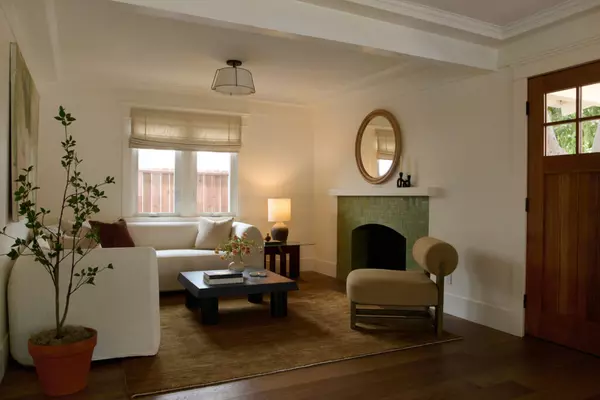
Living The Shipshape Life In Santa Barbara, $4M
Rebuilt over the course of four years by a father (engineer) and son (carpenter) team, this floating Modernist gem—dubbed the Thomas Jefferson—berthed in Santa Barbara Harbor Marina is one of just four houseboats permitted to remain in the marina after municipal codes were changed. While the marina still permits live-aboard boats, the 2015 ban on future houseboats was part of an effort to keep the working and recreational character of the waterfront intact, and it’s easy to see the appeal of a houseboat in the American Riviera—the Pacific Ocean on one side, the Santa Barbara Mountains on the other, and the city nestled in between.Photo Credit: Roy Hathon for Sotheby’s International RealtyAside from the immense porthole window in the kitchen, there are no nautical references (or kitsch) in this straightforward, almost Brutalist, pied-a-mer; the immaculate carpentry is rift oak and not the standard mirror-finished nautical teak. And while the listing ambitiously specifies two bedrooms, the second level is more like an open loft with a spacious bath; the lower level bedroom is currently used as a textile studio.Photo Credit: Roy Hathon for Sotheby’s International RealtyPhoto Credit: Roy Hathon for Sotheby’s International RealtyPhoto Credit: Roy Hathon for Sotheby’s International RealtyPhoto Credit: Roy Hathon for Sotheby’s International RealtyPhoto Credit: Roy Hathon for Sotheby’s International RealtyGo to the listing for additional images and details. An outstanding opportunity to own a never-to-be-repeated Modernist houseboat in one of the world’s most beautiful settings, represented by Patricia Ruben of Sotheby’s International Realty.Photo Credit: Roy Hathon for Sotheby’s International RealtyTop Photo: Roy Hathon for Sotheby’s International RealtyThe post Living The Shipshape Life In Santa Barbara, $4M appeared first on California Home+Design.

Classic 1969 Tract Housing Done Right, $2M
Set in a 6.5-acre gated community overlooking the Virginia Country Club golf course, this c.1969 Modernist ranch exemplifies the booming economy and optimistic suburban style of mid-century Long Beach, where, adjacent to Los Angeles, the intertwined defense and aerospace industries, along with oil and a vast naval base, were the engines of prosperity.At a time when what you lived in could carry political weight—prosperous educated liberals might live in radical Modernist dwellings while prosperous conservatives skewed to Monterey Colonials—this home meets in the middle with walls of glass, classic board-and-batten siding and exposed beams under broad low-pitched roofs. The 4-bed, 3.5-bath home has been extensively and sensitively remodeled, bringing mid-century Southern California well into the 21st Century.Photo Credit: Sterling ReedPhoto Credit: Sterling ReedPhoto Credit: Sterling ReedPhoto Credit: Sterling ReedPhoto Credit: Sterling ReedA partial-height partition in the primary suite, clad in wood, conceals a desk/workspace and a Peloton exercise bike.Photo Credit: Sterling ReedPhoto Credit: Sterling ReedMore: Go to the listing for additional images and details, plus floor plans and a comprehensive overview of the property’s upgrades. An outstanding opportunity to own a piece of Long Beach’s architectural heritage, represented by Nate Cole at Modern California House. See it for yourself– it’s open Sunday, August 25 from 1:00pm to 4:00pm.Photo Credit: Sterling ReedThe post Classic 1969 Tract Housing Done Right, $2M appeared first on California Home+Design.

A Remarkable Survivor: Pasadena’s 1947 Plywood House, $1.64M
The year was 1949—the U.S. was well on its way to economic recovery after WWII, but there was still a chronic housing shortage. The now-famous Case Study House program began in response to the need for economical and efficient building solutions in the LA area, but there were other innovative efforts led by architects like Lawrence Test, who designed this residence for a plywood company salesman, Henry Hernly, in Pasadena. Unlike conventional structures, plywood was set entirely within the redwood post-and-beam structure, using marine-grade plywood for the exterior-facing panels and mahogany, elm and beech instead of conventional plaster on the interior. Photo Credit: Cameron CarothersPerhaps just as important, the Hernly House setting was an early Southern California landscape project designed by the renowned Garrett Eckbo. Under the careful, sympathetic stewardship of only two owners in nearly six decades, home is in remarkably good condition, and as one of Pasadena’s most important Modernist structures, the Hernly House is noted in Robert Winter and David Gebhart’s essential Architectural Guidebook to Los Angeles, and is eligible for Mills Act tax incentives.Photo Credit: Cameron CarothersPhoto Credit: Cameron CarothersPhoto Credit: Cameron CarothersPhoto Credit: Cameron CarothersMore: Go to the listing for additional details and images, including period Julius Shulman images; there’s also a brief IG video that tells the story best. A unique opportunity to acquire a seminal work of Mid-Century architecture and landscape design, represented by veteran architecture expert, broker Brian Lindner of Compass.Photo Credit: Cameron CarothersThe post A Remarkable Survivor: Pasadena’s 1947 Plywood House, $1.64M appeared first on California Home+Design.
Categories
Recent Posts











